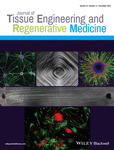In vivo implantation of a tissue engineered stem cell seeded hemi-laryngeal replacement maintains airway, phonation, and swallowing in pigs
Funding information
Medical Research Council, Grant/Award Number: G1001539, RegenVOX1 (G1001539); NPIMR
Abstract
Laryngeal functional impairment relating to swallowing, vocalisation, and respiration can be life changing and devastating for patients. A tissue engineering approach to regenerating vocal folds would represent a significant advantage over current clinical practice.
Porcine hemi-larynx were de-cellularised under negative pressure. The resultant acellular scaffold was seeded with human bone marrow derived mesenchymal stem cells and primary human epithelial cells. Seeded scaffolds were implanted orthotopically into a defect created in the thyroid cartilage in 8 pigs and monitored in vivo for 2 months. In vivo assessments consisted of mucosal brushing and bronchoscopy at 1, 2, 4, and 8 weeks post implantation followed by histological evaluation post termination. The implanted graft had no adverse effect on respiratory function in 6 of the 8 pigs; none of the pigs had problems with swallowing or vocalisation. Six out of the 8 animals survived to the planned termination date; 2 animals were terminated due to mild stenosis and deep tissue abscess formation, respectively. Human epithelial cells from mucosal brushings could only be identified at Weeks 1 and 4. The explanted tissue showed complete epithelialisation of the mucosal surface and the development of rudimentary vocal folds. However, there was no evidence of cartilage remodelling at the relatively early censor point. Single stage partial laryngeal replacement is a safe surgical procedure. Replacement with a tissue engineered laryngeal graft as a single procedure is surgically feasible and results in appropriate mucosal coverage and rudimentary vocal fold development.
CONFLICT OF INTEREST
The authors have declared that there is no conflict of interest.




